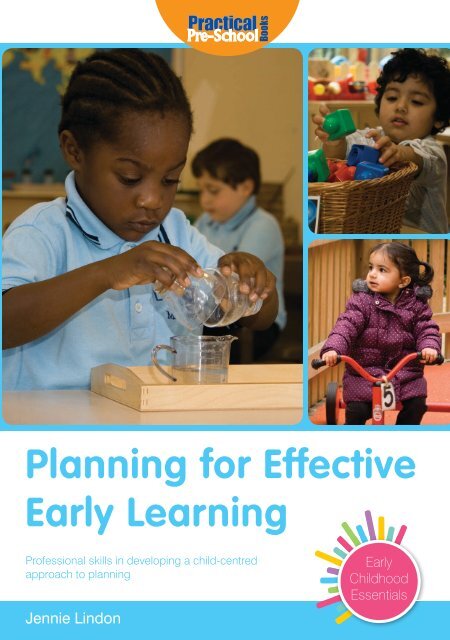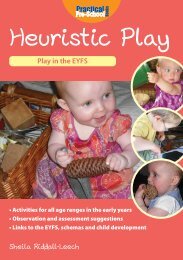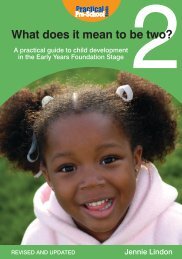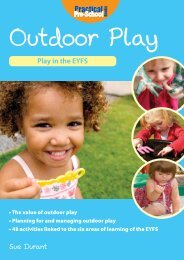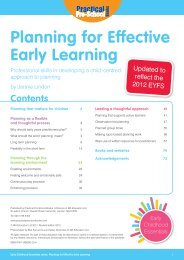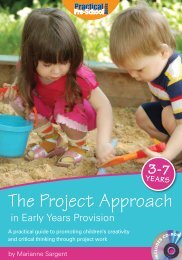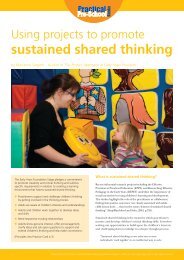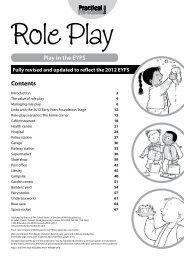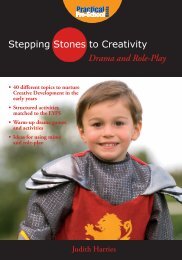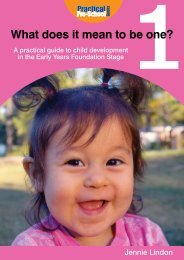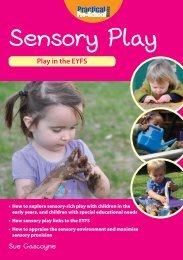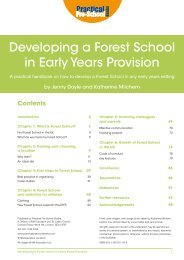Planning for Effective Early Learning - Practical Pre-School Books
Planning for Effective Early Learning - Practical Pre-School Books
Planning for Effective Early Learning - Practical Pre-School Books
Create successful ePaper yourself
Turn your PDF publications into a flip-book with our unique Google optimized e-Paper software.
<strong>Books</strong><br />
<strong>Planning</strong> <strong>for</strong> <strong>Effective</strong><br />
<strong>Early</strong> <strong>Learning</strong><br />
Professional skills in developing a child-centred<br />
approach to planning<br />
Jennie Lindon<br />
<strong>Early</strong><br />
Childhood<br />
Essentials
<strong>Books</strong><br />
<strong>Planning</strong> <strong>for</strong> <strong>Effective</strong><br />
<strong>Early</strong> <strong>Learning</strong><br />
Professional skills in developing a child-centred approach to planning<br />
by Jennie Lindon<br />
Contents<br />
<strong>Planning</strong> that matters <strong>for</strong> children 2<br />
<strong>Planning</strong> as a flexible<br />
and thoughtful process 3<br />
Why should early years practitioners plan 3<br />
What should the word ‘planning’ mean 3<br />
Long term planning 6<br />
Flexibility in the short term 14<br />
<strong>Planning</strong> through the<br />
learning environment 23<br />
Leading a thoughtful approach 41<br />
<strong>Planning</strong> that supports active learners 41<br />
Observation-led planning 47<br />
Planned group times 55<br />
Making topic-based planning work 58<br />
Wise use of written resources <strong>for</strong> practitioners 68<br />
<strong>Books</strong> and websites 70<br />
Acknowledgements 72<br />
Enabling environments 23<br />
Feeling welcome and emotionally safe 24<br />
Continuous play provision 30<br />
Enhancing provision 35<br />
Published by <strong>Practical</strong> <strong>Pre</strong>-<strong>School</strong> books, A Division of MA Education Ltd,<br />
St Jude’s Church, Dulwich Road, Herne Hill, London, SE24 0Pb.<br />
Tel: 020 7738 5454<br />
www.practicalpreschoolbooks.com<br />
© MA Education Ltd 2011<br />
All photos © MA Education Ltd. Photos taken by ben Suri.<br />
Front cover (clockwise): © MA Education Ltd 2010, © MA Education Ltd 2011, © MA Education Ltd 2011<br />
All rights reserved. No part of this publication may be reproduced, stored in a retrieval system, or transmitted<br />
by any means, electronic, mechanical, photocopied or otherwise, without the prior permission of the publisher.<br />
ISbN 978-1-907241-15-4<br />
<strong>Early</strong><br />
Childhood<br />
Essentials<br />
<strong>Early</strong> Childhood Essentials series: <strong>Planning</strong> <strong>for</strong> <strong>Effective</strong> <strong>Early</strong> <strong>Learning</strong> 1
Introduction<br />
<strong>Planning</strong> that matters<br />
<strong>for</strong> children<br />
Across the UK, national frameworks <strong>for</strong> early years provision<br />
expect that practitioners should use their adult ability to be<br />
thoughtful, along with their greater knowledge than any young<br />
child can have accumulated. In all the different types of early<br />
years provision, adults’ ef<strong>for</strong>t over planning should enable a<br />
breadth of experiences that young children judge to be worth<br />
their time and energy: worth exploring, worth talking and thinking<br />
about, worth revisiting, recalling and sharing with other people.<br />
<strong>Planning</strong> matters; I will stand up <strong>for</strong> the importance of planning<br />
as an integral part of best early years practice. Yet a proportion of<br />
early years practitioners are uncertain, sometimes anxious, about<br />
how to plan in ways that genuinely support children’s learning<br />
and contribute to an enjoyable and satisfying early childhood.<br />
A very great deal rests upon what early years practitioners<br />
believe – and have been told - is meant by the words<br />
‘planning’ and ‘plans’. When practitioners say, “We’re<br />
supposed to plan”, what kind of activity is uppermost in<br />
their mind<br />
In my training and consultancy, I became increasingly<br />
aware that, <strong>for</strong> some of the early years work<strong>for</strong>ce ‘planning’<br />
exclusively means written plans. There is nothing the matter<br />
with writing down <strong>for</strong>ward plans that have evolved from a<br />
thoughtful process of planning. When children are involved in<br />
planning that is meaningful to them, they are often keen that<br />
somebody should, “Write down our important ideas” and “We<br />
mustn’t <strong>for</strong>get what we’ve decided”. The problems arise when<br />
plans have been drafted in detail, sometimes well in advance<br />
and practitioners are uneasy about letting a plan change in<br />
response to children’s expressed interests on the day. Such<br />
problems multiply when the written plan has been created by<br />
adults who have no personal knowledge of these individual<br />
young children.<br />
This book explores ways to understand the process of looking<br />
ahead on behalf of young learners – without getting bogged<br />
down in the kind of pre-packaged activity approach that takes<br />
the zest out of potentially enjoyable experiences. The book is<br />
broken down into three key sections:<br />
• Why is planning important and what is meant by ‘planning’<br />
and ‘plans’ What kind of planning works best to support<br />
young children as they learn (pages 3-14)<br />
• <strong>Planning</strong> within early childhood provision that flows through<br />
the learning environment - with examples to show what best<br />
practice <strong>for</strong> young children looks like in action. (pages 23-35)<br />
<strong>Planning</strong> should enable a breadth of experiences<br />
• The role of leading good practice: helping others to<br />
understand the key issues and pathways to improving<br />
current practice. (pages 41-68)<br />
2 <strong>Early</strong> Childhood Essentials series: <strong>Planning</strong> <strong>for</strong> <strong>Effective</strong> <strong>Early</strong> <strong>Learning</strong>
Chapter 1<br />
<strong>Planning</strong> as a flexible<br />
and thoughtful process<br />
Why should early years<br />
practitioners plan<br />
<strong>Planning</strong> does matter; a developmentally appropriate approach<br />
to planning can make a positive difference to the experiences of<br />
young children. However, the reflective approach that needs to go<br />
hand-in-hand with planning starts with this question: “Why plan”.<br />
Asking “Why”, or “What <strong>for</strong>” if you prefer, addresses the best list<br />
of priorities when planning <strong>for</strong> young children’s learning.<br />
The top priority should be that early years practitioners give<br />
time and energy to planning in order to benefit the children. You<br />
consider what you offer and in what ways, because you are<br />
committed to providing experiences that are developmentally<br />
appropriate <strong>for</strong> babies, toddlers and young children. You give<br />
energy to getting to know individual children so that anything<br />
you plan will be well suited to their age, ability and current<br />
interests and preferences. You avoid any kind of planning that<br />
rests upon a one-size-fits-all philosophy.<br />
Close behind the benefits to children as an answer to “Why” should<br />
be a focus on the adults who spend their days with young children.<br />
Close attention to planning will enable you and your colleagues<br />
to keep your knowledge of child development fresh. A sensible<br />
approach to planning will allow you to revisit your expectations of<br />
what children might be able to do, as well as what are realistic next<br />
steps. As a professional the planning process is a good way of<br />
keeping you aware of all aspects of development and ensuring that<br />
some potential areas of learning do not push aside others.<br />
PoInt <strong>for</strong> rEfLECtIon<br />
What does useful planning look like<br />
What might happen if early years practitioners did<br />
not bother to plan ahead in any way at all Children’s<br />
experiences with you over early childhood could be very<br />
limited. However much young boys and girls would love<br />
to cook, their familiar adults would never have got around<br />
to organising the ingredients, or even better, going out<br />
together on a shopping trip.<br />
A great deal depends on what practitioners mean by the<br />
word ‘planning’. <strong>Planning</strong> to be able to cook will not be<br />
enjoyable if, in practice, this means children are waiting<br />
while the adult does almost everything. Then they are<br />
allowed to decorate the finished product – and every child<br />
will make a fairy cake whether they want to or not.<br />
There is plenty of space <strong>for</strong> discussion between the two<br />
extremes <strong>for</strong> planning. Young children do not enjoy, nor<br />
benefit from, a highly regimented day or session. On the<br />
other hand, they are not well supported by practitioners<br />
who pass by good opportunities out of fear of ‘interfering’<br />
with children’s play.<br />
in practice no more than written plans – pieces of paper, which<br />
may have no benefit <strong>for</strong> young children at all.<br />
The answer to “Why should we plan” should never be “To<br />
keep the inspector happy” nor “because we have to”. You do<br />
not plan an activity exclusively, or mainly, to meet the goal of<br />
showing another adult that you have plans. This answer to the<br />
“Why” question, and the anxiety that usually underpins it, is a<br />
warning that practitioners have been persuaded into believing<br />
that planning is not a thoughtful process. Instead, planning is<br />
What should the word<br />
’planning’ mean<br />
<strong>Planning</strong> is an active process, either working as an individual,<br />
thoughtful practitioner, or when a small group of people get<br />
<strong>Early</strong> Childhood Essentials series: <strong>Planning</strong> <strong>for</strong> <strong>Effective</strong> <strong>Early</strong> <strong>Learning</strong> 3
<strong>Planning</strong> as a flexible and thoughtful process<br />
Example: planning <strong>for</strong> young children<br />
Enjoyment with ‘in’, ‘through’ and ‘out again’<br />
In Grove House Infant and Toddler Centre several children<br />
were keen to practise their balancing on a low course created<br />
by hard plastic planks resting on blocks and making a fivesided<br />
shape. Older toddlers and twos walked around this<br />
challenge, with a helping hand available if they wanted it.<br />
Several two-year-olds were also enthusiastic about practising<br />
their already impressive jumping skills (see page 16).<br />
team had decided to remove a climbing and sliding large<br />
piece of equipment, since it occupied quite a lot of space.<br />
Their decision had enabled them to bring in separate items of<br />
equipment that could be used in a more flexible way to support<br />
young children’s physical skills. So, within the week of my visit<br />
the team had the space to lay out equipment well suited to<br />
meet the children’s wish to balance, clamber and jump.<br />
In terms of planning to support ‘next steps’, this example is about<br />
the literal next steps <strong>for</strong> very young children. The adult shortterm<br />
decision was closely linked with what they had observed.<br />
A number of the children wanted to balance and an appropriate<br />
next step was to offer exactly that opportunity. This option was<br />
possible because of the approach to long-term and short-term<br />
planning within the Infant and Toddler Centre (ITC) team.<br />
The ITC team had planned ahead over the last year to<br />
reorganise their outdoor learning environment. The resources<br />
<strong>for</strong> balancing were a useful reminder, along with the barrel and<br />
base, that opportunities <strong>for</strong> clambering, jumping or balancing<br />
do not depend on fixed climbing equipment. In fact, as part<br />
of the re-thinking of the under threes outdoor space, the ITC<br />
The ITC team plan enhancements to the permanent play<br />
provision – indoors as well as outside – from what they<br />
observe has interested these very young children. These<br />
short-term planned changes happen within the week, often<br />
the next day and sometimes as an immediate response to<br />
something a child does or says (see page 21).<br />
The ITC team, along with the nursery team of Grove House<br />
Children’s Centre, also apply the skills of planning to<br />
ensuring plenty of time <strong>for</strong> children to become immersed in<br />
their current interest. <strong>Planning</strong> around deployment of adults<br />
ensures that practitioners are easily available <strong>for</strong> children.<br />
The shared understanding is that any adult-initiated activity is<br />
left flexible <strong>for</strong> children to influence.<br />
4 <strong>Early</strong> Childhood Essentials series: <strong>Planning</strong> <strong>for</strong> <strong>Effective</strong> <strong>Early</strong> <strong>Learning</strong>
Chapter 3<br />
Leading a thoughtful<br />
approach<br />
Managers and other senior practitioners are responsible <strong>for</strong><br />
guiding the early years team towards an approach to planning<br />
that genuinely supports young learning. Practitioners who<br />
usually work alone, such as childminders, can feel isolated over<br />
this kind of professional reflection. So, it is important to draw on<br />
available local support such as early years advisors with special<br />
responsibility <strong>for</strong> the childminding service and local networks.<br />
<strong>Planning</strong> that supports<br />
active learners<br />
Part of the senior role has to be a clear understanding of what<br />
is, and is not, required in the national early years framework<br />
that applies to your part of the UK. The national early years<br />
frameworks across the UK all expect that practitioners will<br />
exercise their skills of planning. The details vary between the<br />
four countries of the UK: the <strong>Early</strong> Years Foundation Stage<br />
(EYFS) in England (DCSF, 2008), the Foundation Phase in<br />
Wales (Welsh Assembly Government, 2008), the Curriculum in<br />
Excellence in Scotland (The Scottish Government, 2008) and<br />
the possibilities in the <strong>Early</strong> Years (0-6) Strategy in process in<br />
Northern Ireland (Department of Education, 2010).<br />
Managers and senior practitioners have to become familiar<br />
with the early years framework that applies to them. The task is<br />
very often to be crystal clear about what is non-negotiable: the<br />
statutory part of any framework. These requirements are different<br />
from guidance: the part of a pack or additional publications that<br />
provide explanations, ideas, suggestions and maybe specific<br />
examples of practice. For instance, in England the EYFS main<br />
pack included both a statutory section and a guidance section,<br />
supplemented by the Principles into Practice cards. Many<br />
other booklets and CDs followed from the National Strategies<br />
team. These were all guidance documents, although they have<br />
sometimes been discussed as if everyone has to follow any<br />
suggested pro<strong>for</strong>ma <strong>for</strong> observation, recording and planning.<br />
Within their different <strong>for</strong>mats the different early years statutory<br />
frameworks have strands in common that apply to planning:<br />
• The importance of learning through the medium of play<br />
within early childhood – with a balance between experiences<br />
planned by adults and children’s self-chosen play.<br />
• <strong>Planning</strong> by practitioners should pay close attention to the<br />
interests and current development of individual children.<br />
• This observation-led planning should enable young children<br />
to stretch beyond their current skills and understanding, but<br />
should not impose unrealistic expectations.<br />
• Forward planning should place equal value on all the areas<br />
of learning <strong>for</strong> development over early childhood, as they are<br />
described in this framework.<br />
• <strong>Planning</strong> and evaluation of experiences should acknowledge<br />
how a positive experience <strong>for</strong> young children will support<br />
more than one area of learning.<br />
Leading a team, or thinking deeply about your own practice,<br />
involves reflection around what these key strands mean and<br />
how some beliefs about planning could disrupt young learning.<br />
For instance, a positive focus on learning through play can<br />
be undermined by some interpretations of phrases much<br />
used in documents such as ‘well planned play’ or ‘structured<br />
play’. The more adult-dominated approaches to planning risk<br />
imposing so much structure onto an alleged play activity that<br />
any playfulness has been organised out of the experience<br />
(Lindon, 2001 and 2010b). A developmentally appropriate<br />
interpretation of planning around play leads to experiences<br />
that familiar practitioners have organised on the basis of<br />
knowledge of these young children, who then enjoy this time.<br />
It is never good early years practice when everything has been<br />
decided, by the adults, be<strong>for</strong>e children ever get their eyes and<br />
<strong>Early</strong> Childhood Essentials series: <strong>Planning</strong> <strong>for</strong> <strong>Effective</strong> <strong>Early</strong> <strong>Learning</strong> 41
Leading a thoughtful approach<br />
Example: cutting and drawing<br />
Cutting and making<br />
A chance to draw with biros<br />
In Grove House Infant and Toddler Centre three older toddlers<br />
and twos were enjoying a simple activity of cutting cereal<br />
boxes, occasionally squashing them as well, and adding strips<br />
of paper. They took breaks to chat and look at what the other<br />
children at the table had chosen to do.<br />
The practitioner sitting with the children had planned this<br />
activity from her observations that some children wanted<br />
to cut with scissors but struggled with the skill. She had<br />
gathered the boxes because she knew some of the children<br />
could manage to cut card. She had cut some paper into<br />
strips be<strong>for</strong>ehand, because the children found it difficult to<br />
cut whole sheets of paper. This adjustment enabled some<br />
children to feel a sense of achievement by cutting the strips,<br />
which could also be held taut by an adult. This example<br />
shows attention to appropriate next steps considered by<br />
an adult who knew the children well. She had prepared just<br />
enough to enable these young children to extend their skills.<br />
On a table in the front room some twos were busy with large<br />
pieces of paper. They had crayons and biros but several<br />
children over the morning were most enthused about using<br />
the biros. Young boys and girls focussed carefully, out of<br />
choice, and made a series of deliberate swirly marks, some<br />
of them tight spirals of repeated circling movements. Later<br />
in the day other children were drawing spiders and spidery<br />
shapes. They all held their biro with care and regularly<br />
stopped to look closely at what they had done be<strong>for</strong>e<br />
resuming this meaningful mark making. The children chose<br />
what to draw but adults were ready to admire what they<br />
managed. At one point a practitioner said, ‘Fantastic’ about a<br />
very detailed drawing done by a young boy and he repeated<br />
the word accurately – with a pleased expression on his face.<br />
These very young children were able to select from resources<br />
made available on the basis of adult observations of existing<br />
skills. The children are secure within their learning journey<br />
towards literacy, in terms of making deliberate and meaningful<br />
marks. Appropriate next steps will be more opportunities<br />
like this, as well as the support from the children’s learning<br />
environment which shows writing <strong>for</strong> a reason, along with visual<br />
material. There is good reason to predict that children will be fully<br />
confident in their skills of mark making by the time the abstract<br />
concept of written letters has begun to make sense to them.<br />
42 <strong>Early</strong> Childhood Essentials series: <strong>Planning</strong> <strong>for</strong> <strong>Effective</strong> <strong>Early</strong> <strong>Learning</strong>


